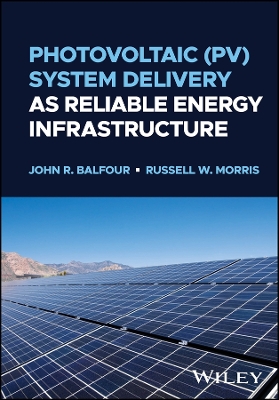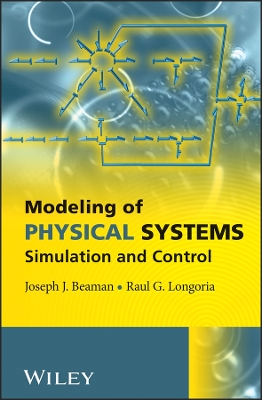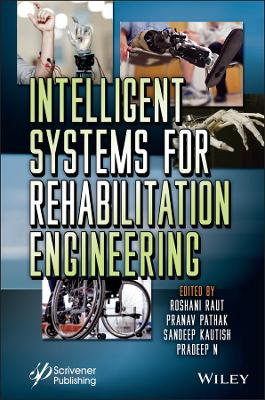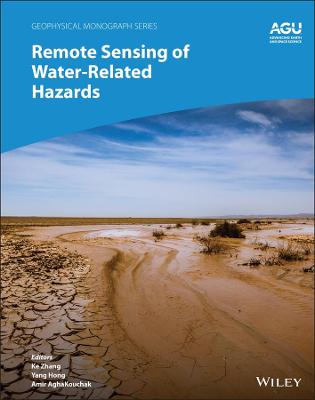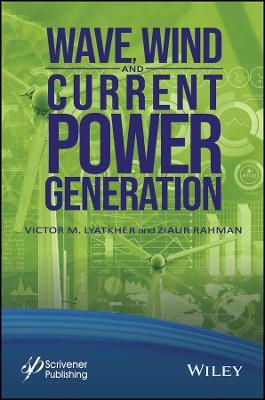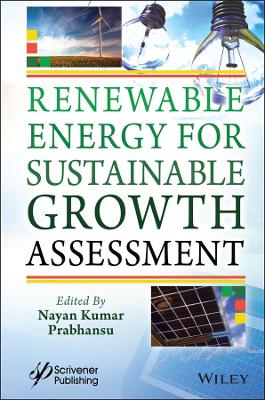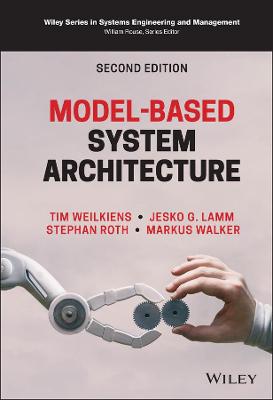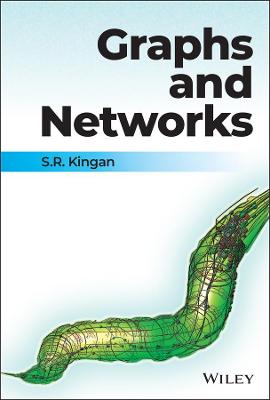Solar Engineering of Thermal Processes, Photovoltaics and Wind
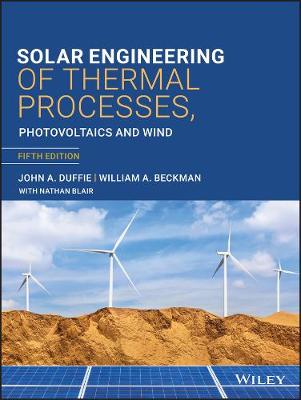 -15%
portes grátis
-15%
portes grátis
Solar Engineering of Thermal Processes, Photovoltaics and Wind
Beckman, William A.; Blair, Nathan; Duffie, John A.
John Wiley & Sons Inc
04/2020
928
Dura
Inglês
9781119540281
15 a 20 dias
1534
Preface to the Fourth Edition xiii
Preface to the Third Edition xv
Preface to the Second Edition xvii
Preface to the First Edition xix
Part I Fundamentals 1
1 Solar Radiation 3
1.1 The Sun 3
1.2 The Solar Constant 5
1.3 Spectral Distribution of Extraterrestrial Radiation 6
1.4 Variation of Extraterrestrial Radiation 8
1.5 Definitions 9
1.6 Direction of Beam Radiation 12
1.7 Angles for Tracking Surfaces 20
1.8 Ratio of Beam Radiation on Tilted Surface to That on Horizontal Surface 24
1.9 Shading 30
1.10 Extraterrestrial Radiation on a Horizontal Surface 37
1.11 Summary 41
References 43
2 Available Solar Radiation 45
2.1 Definitions 45
2.2 Pyrheliometers and Pyrheliometric Scales 46
2.3 Pyranometers 50
2.4 Measurement of Duration of Sunshine 55
2.5 Solar Radiation Data 56
2.6 Atmospheric Attenuation of Solar Radiation 61
2.7 Estimation of Average Solar Radiation 66
2.8 Estimation of Clear-Sky Radiation 70
2.9 Distribution of Clear and Cloudy Days and Hours 73
2.10 Beam and Diffuse Components of Hourly Radiation 76
2.11 Beam and Diffuse Components of Daily Radiation 79
2.12 Beam and Diffuse Components of Monthly Radiation 81
2.13 Estimation of Hourly Radiation from Daily Data 83
2.14 Radiation on Sloped Surfaces 86
2.15 Radiation on Sloped Surfaces: Isotropic Sky 91
2.16 Radiation on Sloped Surfaces: Anisotropic Sky 92
2.17 Radiation Augmentation 98
2.18 Beam Radiation on Moving Surfaces 103
2.19 Average Radiation on Sloped Surfaces: Isotropic Sky 104
2.20 Average Radiation on Sloped Surfaces: KT Method 108
2.21 Effects of Receiving Surface Orientation on HT 114
2.22 Utilizability 116
2.23 Generalized Utilizability 120
2.24 Daily Utilizability 128
2.25 Summary 134
References 136
3 Selected Heat Transfer Topics 141
3.1 The Electromagnetic Spectrum 141
3.2 Photon Radiation 142
3.3 The Blackbody: Perfect Absorber and Emitter 142
3.4 Planck's Law and Wien's Displacement Law 143
3.5 Stefan-Boltzmann Equation 144
3.6 Radiation Tables 145
3.7 Radiation Intensity and Flux 147
3.8 Infrared Radiation Exchange Between Gray Surfaces 149
3.9 Sky Radiation 150
3.10 Radiation Heat Transfer Coefficient 151
3.11 Natural Convection Between Flat Parallel Plates and Between Concentric Cylinders 152
3.12 Convection Suppression 157
3.13 Vee-Corrugated Enclosures 161
3.14 Heat Transfer Relations for Internal Flow 162
3.15 Wind Convection Coefficients 166
3.16 Heat Transfer and Pressure Drop in Packed Beds and Perforated Plates 168
3.17 Effectiveness-NTU Calculations for Heat Exchangers 171
3.18 Summary 173
References 174
4 Radiation Characteristics of Opaque Materials 177
4.1 Absorptance and Emittance 178
4.2 Kirchhoff's Law 180
4.3 Reflectance of Surfaces 181
4.4 Relationships Among Absorptance, Emittance, and Reflectance 185
4.5 Broadband Emittance and Absorptance 186
4.6 Calculation of Emittance and Absorptance 187
4.7 Measurement of Surface Radiation Properties 190
4.8 Selective Surfaces 192
4.9 Mechanisms of Selectivity 196
4.10 Optimum Properties 199
4.11 Angular Dependence of Solar Absorptance 200
4.12 Absorptance of Cavity Receivers 201
4.13 Specularly Reflecting Surfaces 202
4.14 Advanced Radiation Heat Transfer Analysis 203
4.15 Summary 205
References 206
5 Radiation Transmission through Glazing: Absorbed Radiation 209
5.1 Reflection of Radiation 209
5.2 Absorption by Glazing 213
5.3 Optical Properties of Cover Systems 213
5.4 Transmittance for Diffuse Radiation 218
5.5 Transmittance-Absorptance Product 220
5.6 Angular Dependence of (????) 221
5.7 Spectral Dependence of Transmittance 222
5.8 Effects of Surface Layers on Transmittance 225
5.9 Absorbed Solar Radiation 226
5.10 Monthly Average Absorbed Radiation 230
5.11 Absorptance of Rooms 236
5.12 Absorptance of Photovoltaic Cells 238
5.13 Summary 241
References 243
6 Flat-Plate Collectors 244
6.1 Description of Flat-Plate Collectors 244
6.2 Basic Flat-Plate Energy Balance Equation 245
6.3 Temperature Distributions in Flat-Plate Collectors 246
6.4 Collector Overall Heat Loss Coefficient 248
6.5 Temperature Distribution Between Tubes and the Collector Efficiency Factor 262
6.6 Temperature Distribution in Flow Direction 269
6.7 Collector Heat Removal Factor and Flow Factor 270
6.8 Critical Radiation Level 274
6.9 Mean Fluid and Plate Temperatures 275
6.10 Effective Transmittance-Absorptance Product 276
6.11 Effects of Dust and Shading 279
6.12 Heat Capacity Effects in Flat-Plate Collectors 280
6.13 Liquid Heater Plate Geometries 283
6.14 Air Heaters 288
6.15 Measurements of Collector Performance 295
6.16 Collector Characterizations 296
6.17 Collector Tests: Efficiency, Incidence Angle Modifier, and Time Constant 297
6.18 Test Data 307
6.19 Thermal Test Data Conversion 310
6.20 Flow Rate Corrections to FR (????)n and FRUL 313
6.21 Flow Distribution in Collectors 316
6.22 In Situ Collector Performance 317
6.23 Practical Considerations for Flat-Plate Collectors 318
6.24 Putting It All Together 321
6.25 Summary 326
References 327
7 Concentrating Collectors 331
7.1 Collector Configurations 332
7.2 Concentration Ratio 334
7.3 Thermal Performance of Concentrating Collectors 336
7.4 Optical Performance of Concentrating Collectors 343
7.5 Cylindrical Absorber Arrays 344
7.6 Optical Characteristics of Nonimaging Concentrators 346
7.7 Orientation and Absorbed Energy for CPC Collectors 354
7.8 Performance of CPC Collectors 358
7.9 Linear Imaging Concentrators: Geometry 360
7.10 Images Formed by Perfect Linear Concentrators 363
7.11 Images from Imperfect Linear Concentrators 368
7.12 Ray-Trace Methods for Evaluating Concentrators 370
7.13 Incidence Angle Modifiers and Energy Balances 370
7.14 Paraboloidal Concentrators 376
7.15 Central-Receiver Collectors 377
7.16 Practical Considerations 378
7.17 Summary 379
References 380
8 Energy Storage 382
8.1 Process Loads and Solar Collector Outputs 382
8.2 Energy Storage in Solar Thermal Systems 384
8.3 Water Storage 385
8.4 Stratification in Storage Tanks 388
8.5 Packed-Bed Storage 393
8.6 Storage Walls 401
8.7 Seasonal Storage 403
8.8 Phase Change Energy Storage 405
8.9 Chemical Energy Storage 410
8.10 Battery Storage 411
8.11 Hydroelectric and Compressed Air Storage 415
8.12 Summary 418
References 419
9 Solar Process Loads 422
9.1 Examples of Time-Dependent Loads 423
9.2 Hot-Water Loads 424
9.3 Space Heating Loads, Degree-Days, and Balance Temperature 425
9.4 Building Loss Coefficients 428
9.5 Building Energy Storage Capacity 430
9.6 Cooling Loads 430
9.7 Swimming Pool Heating Loads 431
9.8 Summary 433
References 434
10 System Thermal Calculations 436
10.1 Component Models 437
10.2 Collector Heat Exchanger Factor 438
10.3 Duct and Pipe Loss Factors 440
10.4 Controls 443
10.5 Collector Arrays: Series Connections 445
10.6 Performance of Partially Shaded Collectors 447
10.7 Series Arrays with Sections Having Different Orientations 449
10.8 Use of Modified Collector Equations 451
10.9 System Models 455
10.10 Solar Fraction and Solar Savings Fraction 458
10.11 Summary 459
References 461
11 Solar Process Economics 462
11.1 Costs of Solar Process Systems 462
11.2 Design Variables 465
11.3 Economic Figures of Merit 467
11.4 Discounting and Inflation 469
11.5 Present-Worth Factor 471
11.6 Life-Cycle Savings Method 474
11.7 Evaluation of Other Economic Indicators 479
11.8 The P1, P2 Method 482
11.9 Uncertainties in Economic Analyses 487
11.10 Economic Analysis Using Solar Savings Fraction 490
11.11 Summary 491
References 491
Part II Applications 493
12 Solar Water Heating: Active and Passive 495
12.1 Water Heating Systems 495
12.2 Freezing, Boiling, and Scaling 499
12.3 Auxiliary Energy 502
12.4 Forced-Circulation Systems 504
12.5 Low-Flow Pumped Systems 505
12.6 Natural-Circulation Systems 507
12.7 Integral Collector Storage Systems 510
12.8 Retrofit Water Heaters 512
12.9 Water Heating in Space Heating and Cooling Systems 512
12.10 Testing and Rating of Solar Water Heaters 513
12.11 Economics of Solar Water Heating 514
12.12 Swimming Pool Heating 517
12.13 Summary 518
References 519
13 Building Heating: Active 521
13.1 Historical Notes 522
13.2 Solar Heating Systems 523
13.3 CSU House III Flat-Plate Liquid System 528
13.4 CSU House II Air System 531
13.5 Heating System Parametric Study 533
13.6 Solar Energy-Heat Pump Systems 537
13.7 Phase Change Storage Systems 542
13.8 Seasonal Energy Storage Systems 545
13.9 Solar and Off-Peak Electric Systems 549
13.10 Solar System Overheating 550
13.11 Solar Heating Economics 551
13.12 Architectural Considerations 554
References 556
14 Building Heating: Passive and Hybrid Methods 559
14.1 Concepts of Passive Heating 560
14.2 Comfort Criteria and Heating Loads 561
14.3 Movable Insulation and Controls 561
14.4 Shading: Overhangs and Wingwalls 562
14.5 Direct-Gain Systems 566
14.6 Collector-Storage Walls and Roofs 571
14.7 Sunspaces 575
14.8 Active Collection-Passive Storage Hybrid Systems 577
14.9 Other Hybrid Systems 578
14.10 Passive Applications 579
14.11 Heat Distribution in Passive Buildings 584
14.12 Costs and Economics of Passive Heating 585
14.13 Summary 587
References 588
15 Solar Cooling 590
15.1 Solar Absorption Cooling 591
15.2 Theory of Absorption Cooling 593
15.3 Combined Solar Heating and Cooling 599
15.4 Simulation Study of Solar Air Conditioning 600
15.5 Operating Experience with Solar Cooling 603
15.6 Applications of Solar Absorption Air Conditioning 606
15.7 Solar Desiccant Cooling 606
15.8 Ventilation and Recirculation Desiccant Cycles 609
15.9 Solar-Mechanical Cooling 611
15.10 Solar-Related Air Conditioning 614
15.11 Passive Cooling 615
References 616
16 Solar Industrial Process Heat 619
16.1 Integration with Industrial Processes 619
16.2 Mechanical Design Considerations 620
16.3 Economics of Industrial Process Heat 621
16.4 Open-Circuit Air Heating Applications 622
16.5 Recirculating Air System Applications 626
16.6 Once-Through Industrial Water Heating 628
16.7 Recirculating Industrial Water Heating 630
16.8 Shallow-Pond Water Heaters 632
16.9 Summary 634
References 634
17 Solar Thermal Power Systems 636
17.1 Thermal Conversion Systems 636
17.2 Gila Bend Pumping System 637
17.3 Luz Systems 639
17.4 Central-Receiver Systems 643
17.5 Solar One and Solar Two Power Plants 645
17.6 Summary 648
References 648
18 Solar Ponds: Evaporative Processes 650
18.1 Salt-Gradient Solar Ponds 650
18.2 Pond Theory 652
18.3 Applications of Ponds 654
18.4 Solar Distillation 655
18.5 Evaporation 661
18.6 Direct Solar Drying 662
18.7 Summary 662
References 663
Part III Design Methods 665
19 Simulations in Solar Process Design 667
19.1 Simulation Programs 668
19.2 Utility of Simulations 668
19.3 Information from Simulations 669
19.4 TRNSYS: Thermal Process Simulation Program 671
19.5 Simulations and Experiments 677
19.6 Meteorological Data 678
19.7 Limitations of Simulations 681
References 681
20 Design of Active Systems: f-Chart 683
20.1 Review of Design Methods 683
20.2 The f-Chart Method 684
20.3 The f-Chart for Liquid Systems 688
20.4 The f-Chart for Air Systems 694
20.5 Service Water Heating Systems 698
20.6 The f-Chart Results 700
20.7 Parallel Solar Energy-Heat Pump Systems 701
20.8 Summary 705
References 705
21 Design of Active Systems by Utilizability Methods 707
21.1 Hourly Utilizability 708
21.2 Daily Utilizability 711
21.3 The ??, f-Chart Method 714
21.4 Summary 724
References 725
22 Design of Passive and Hybrid Heating Systems 726
22.1 Approaches to Passive Design 726
22.2 Solar-Load Ratio Method 727
22.3 Unutilizability Design Method: Direct Gain 736
22.4 Unutilizability Design Method: Collector-Storage Walls 742
22.5 Hybrid Systems: Active Collection with Passive Storage 750
22.6 Other Hybrid Systems 757
22.7 Summary 758
References 758
23 Design of Photovoltaic Systems 760
23.1 Photovoltaic Converters 761
23.2 PV Generator Characteristics and Models 762
23.3 Cell Temperature 773
23.4 Load Characteristics and Direct-Coupled Systems 775
23.5 Controls and Maximum Power Point Trackers 778
23.6 Applications 779
23.7 Design Procedures 780
23.8 High-Flux PV Generators 786
23.9 Summary 786
References 787
24 Wind Energy 789
24.1 Introduction 789
24.2 Wind Resource 793
24.3 One-Dimensional Wind Turbine Model 801
24.4 Estimating Wind Turbine Average Power and Energy Production 806
24.5 Summary 810
References 810
Appendixes 811
A Problems 811
B Nomenclature 870
C International System of Units 875
D Meteorological Data 877
Index 885
Preface to the Fourth Edition xiii
Preface to the Third Edition xv
Preface to the Second Edition xvii
Preface to the First Edition xix
Part I Fundamentals 1
1 Solar Radiation 3
1.1 The Sun 3
1.2 The Solar Constant 5
1.3 Spectral Distribution of Extraterrestrial Radiation 6
1.4 Variation of Extraterrestrial Radiation 8
1.5 Definitions 9
1.6 Direction of Beam Radiation 12
1.7 Angles for Tracking Surfaces 20
1.8 Ratio of Beam Radiation on Tilted Surface to That on Horizontal Surface 24
1.9 Shading 30
1.10 Extraterrestrial Radiation on a Horizontal Surface 37
1.11 Summary 41
References 43
2 Available Solar Radiation 45
2.1 Definitions 45
2.2 Pyrheliometers and Pyrheliometric Scales 46
2.3 Pyranometers 50
2.4 Measurement of Duration of Sunshine 55
2.5 Solar Radiation Data 56
2.6 Atmospheric Attenuation of Solar Radiation 61
2.7 Estimation of Average Solar Radiation 66
2.8 Estimation of Clear-Sky Radiation 70
2.9 Distribution of Clear and Cloudy Days and Hours 73
2.10 Beam and Diffuse Components of Hourly Radiation 76
2.11 Beam and Diffuse Components of Daily Radiation 79
2.12 Beam and Diffuse Components of Monthly Radiation 81
2.13 Estimation of Hourly Radiation from Daily Data 83
2.14 Radiation on Sloped Surfaces 86
2.15 Radiation on Sloped Surfaces: Isotropic Sky 91
2.16 Radiation on Sloped Surfaces: Anisotropic Sky 92
2.17 Radiation Augmentation 98
2.18 Beam Radiation on Moving Surfaces 103
2.19 Average Radiation on Sloped Surfaces: Isotropic Sky 104
2.20 Average Radiation on Sloped Surfaces: KT Method 108
2.21 Effects of Receiving Surface Orientation on HT 114
2.22 Utilizability 116
2.23 Generalized Utilizability 120
2.24 Daily Utilizability 128
2.25 Summary 134
References 136
3 Selected Heat Transfer Topics 141
3.1 The Electromagnetic Spectrum 141
3.2 Photon Radiation 142
3.3 The Blackbody: Perfect Absorber and Emitter 142
3.4 Planck's Law and Wien's Displacement Law 143
3.5 Stefan-Boltzmann Equation 144
3.6 Radiation Tables 145
3.7 Radiation Intensity and Flux 147
3.8 Infrared Radiation Exchange Between Gray Surfaces 149
3.9 Sky Radiation 150
3.10 Radiation Heat Transfer Coefficient 151
3.11 Natural Convection Between Flat Parallel Plates and Between Concentric Cylinders 152
3.12 Convection Suppression 157
3.13 Vee-Corrugated Enclosures 161
3.14 Heat Transfer Relations for Internal Flow 162
3.15 Wind Convection Coefficients 166
3.16 Heat Transfer and Pressure Drop in Packed Beds and Perforated Plates 168
3.17 Effectiveness-NTU Calculations for Heat Exchangers 171
3.18 Summary 173
References 174
4 Radiation Characteristics of Opaque Materials 177
4.1 Absorptance and Emittance 178
4.2 Kirchhoff's Law 180
4.3 Reflectance of Surfaces 181
4.4 Relationships Among Absorptance, Emittance, and Reflectance 185
4.5 Broadband Emittance and Absorptance 186
4.6 Calculation of Emittance and Absorptance 187
4.7 Measurement of Surface Radiation Properties 190
4.8 Selective Surfaces 192
4.9 Mechanisms of Selectivity 196
4.10 Optimum Properties 199
4.11 Angular Dependence of Solar Absorptance 200
4.12 Absorptance of Cavity Receivers 201
4.13 Specularly Reflecting Surfaces 202
4.14 Advanced Radiation Heat Transfer Analysis 203
4.15 Summary 205
References 206
5 Radiation Transmission through Glazing: Absorbed Radiation 209
5.1 Reflection of Radiation 209
5.2 Absorption by Glazing 213
5.3 Optical Properties of Cover Systems 213
5.4 Transmittance for Diffuse Radiation 218
5.5 Transmittance-Absorptance Product 220
5.6 Angular Dependence of (????) 221
5.7 Spectral Dependence of Transmittance 222
5.8 Effects of Surface Layers on Transmittance 225
5.9 Absorbed Solar Radiation 226
5.10 Monthly Average Absorbed Radiation 230
5.11 Absorptance of Rooms 236
5.12 Absorptance of Photovoltaic Cells 238
5.13 Summary 241
References 243
6 Flat-Plate Collectors 244
6.1 Description of Flat-Plate Collectors 244
6.2 Basic Flat-Plate Energy Balance Equation 245
6.3 Temperature Distributions in Flat-Plate Collectors 246
6.4 Collector Overall Heat Loss Coefficient 248
6.5 Temperature Distribution Between Tubes and the Collector Efficiency Factor 262
6.6 Temperature Distribution in Flow Direction 269
6.7 Collector Heat Removal Factor and Flow Factor 270
6.8 Critical Radiation Level 274
6.9 Mean Fluid and Plate Temperatures 275
6.10 Effective Transmittance-Absorptance Product 276
6.11 Effects of Dust and Shading 279
6.12 Heat Capacity Effects in Flat-Plate Collectors 280
6.13 Liquid Heater Plate Geometries 283
6.14 Air Heaters 288
6.15 Measurements of Collector Performance 295
6.16 Collector Characterizations 296
6.17 Collector Tests: Efficiency, Incidence Angle Modifier, and Time Constant 297
6.18 Test Data 307
6.19 Thermal Test Data Conversion 310
6.20 Flow Rate Corrections to FR (????)n and FRUL 313
6.21 Flow Distribution in Collectors 316
6.22 In Situ Collector Performance 317
6.23 Practical Considerations for Flat-Plate Collectors 318
6.24 Putting It All Together 321
6.25 Summary 326
References 327
7 Concentrating Collectors 331
7.1 Collector Configurations 332
7.2 Concentration Ratio 334
7.3 Thermal Performance of Concentrating Collectors 336
7.4 Optical Performance of Concentrating Collectors 343
7.5 Cylindrical Absorber Arrays 344
7.6 Optical Characteristics of Nonimaging Concentrators 346
7.7 Orientation and Absorbed Energy for CPC Collectors 354
7.8 Performance of CPC Collectors 358
7.9 Linear Imaging Concentrators: Geometry 360
7.10 Images Formed by Perfect Linear Concentrators 363
7.11 Images from Imperfect Linear Concentrators 368
7.12 Ray-Trace Methods for Evaluating Concentrators 370
7.13 Incidence Angle Modifiers and Energy Balances 370
7.14 Paraboloidal Concentrators 376
7.15 Central-Receiver Collectors 377
7.16 Practical Considerations 378
7.17 Summary 379
References 380
8 Energy Storage 382
8.1 Process Loads and Solar Collector Outputs 382
8.2 Energy Storage in Solar Thermal Systems 384
8.3 Water Storage 385
8.4 Stratification in Storage Tanks 388
8.5 Packed-Bed Storage 393
8.6 Storage Walls 401
8.7 Seasonal Storage 403
8.8 Phase Change Energy Storage 405
8.9 Chemical Energy Storage 410
8.10 Battery Storage 411
8.11 Hydroelectric and Compressed Air Storage 415
8.12 Summary 418
References 419
9 Solar Process Loads 422
9.1 Examples of Time-Dependent Loads 423
9.2 Hot-Water Loads 424
9.3 Space Heating Loads, Degree-Days, and Balance Temperature 425
9.4 Building Loss Coefficients 428
9.5 Building Energy Storage Capacity 430
9.6 Cooling Loads 430
9.7 Swimming Pool Heating Loads 431
9.8 Summary 433
References 434
10 System Thermal Calculations 436
10.1 Component Models 437
10.2 Collector Heat Exchanger Factor 438
10.3 Duct and Pipe Loss Factors 440
10.4 Controls 443
10.5 Collector Arrays: Series Connections 445
10.6 Performance of Partially Shaded Collectors 447
10.7 Series Arrays with Sections Having Different Orientations 449
10.8 Use of Modified Collector Equations 451
10.9 System Models 455
10.10 Solar Fraction and Solar Savings Fraction 458
10.11 Summary 459
References 461
11 Solar Process Economics 462
11.1 Costs of Solar Process Systems 462
11.2 Design Variables 465
11.3 Economic Figures of Merit 467
11.4 Discounting and Inflation 469
11.5 Present-Worth Factor 471
11.6 Life-Cycle Savings Method 474
11.7 Evaluation of Other Economic Indicators 479
11.8 The P1, P2 Method 482
11.9 Uncertainties in Economic Analyses 487
11.10 Economic Analysis Using Solar Savings Fraction 490
11.11 Summary 491
References 491
Part II Applications 493
12 Solar Water Heating: Active and Passive 495
12.1 Water Heating Systems 495
12.2 Freezing, Boiling, and Scaling 499
12.3 Auxiliary Energy 502
12.4 Forced-Circulation Systems 504
12.5 Low-Flow Pumped Systems 505
12.6 Natural-Circulation Systems 507
12.7 Integral Collector Storage Systems 510
12.8 Retrofit Water Heaters 512
12.9 Water Heating in Space Heating and Cooling Systems 512
12.10 Testing and Rating of Solar Water Heaters 513
12.11 Economics of Solar Water Heating 514
12.12 Swimming Pool Heating 517
12.13 Summary 518
References 519
13 Building Heating: Active 521
13.1 Historical Notes 522
13.2 Solar Heating Systems 523
13.3 CSU House III Flat-Plate Liquid System 528
13.4 CSU House II Air System 531
13.5 Heating System Parametric Study 533
13.6 Solar Energy-Heat Pump Systems 537
13.7 Phase Change Storage Systems 542
13.8 Seasonal Energy Storage Systems 545
13.9 Solar and Off-Peak Electric Systems 549
13.10 Solar System Overheating 550
13.11 Solar Heating Economics 551
13.12 Architectural Considerations 554
References 556
14 Building Heating: Passive and Hybrid Methods 559
14.1 Concepts of Passive Heating 560
14.2 Comfort Criteria and Heating Loads 561
14.3 Movable Insulation and Controls 561
14.4 Shading: Overhangs and Wingwalls 562
14.5 Direct-Gain Systems 566
14.6 Collector-Storage Walls and Roofs 571
14.7 Sunspaces 575
14.8 Active Collection-Passive Storage Hybrid Systems 577
14.9 Other Hybrid Systems 578
14.10 Passive Applications 579
14.11 Heat Distribution in Passive Buildings 584
14.12 Costs and Economics of Passive Heating 585
14.13 Summary 587
References 588
15 Solar Cooling 590
15.1 Solar Absorption Cooling 591
15.2 Theory of Absorption Cooling 593
15.3 Combined Solar Heating and Cooling 599
15.4 Simulation Study of Solar Air Conditioning 600
15.5 Operating Experience with Solar Cooling 603
15.6 Applications of Solar Absorption Air Conditioning 606
15.7 Solar Desiccant Cooling 606
15.8 Ventilation and Recirculation Desiccant Cycles 609
15.9 Solar-Mechanical Cooling 611
15.10 Solar-Related Air Conditioning 614
15.11 Passive Cooling 615
References 616
16 Solar Industrial Process Heat 619
16.1 Integration with Industrial Processes 619
16.2 Mechanical Design Considerations 620
16.3 Economics of Industrial Process Heat 621
16.4 Open-Circuit Air Heating Applications 622
16.5 Recirculating Air System Applications 626
16.6 Once-Through Industrial Water Heating 628
16.7 Recirculating Industrial Water Heating 630
16.8 Shallow-Pond Water Heaters 632
16.9 Summary 634
References 634
17 Solar Thermal Power Systems 636
17.1 Thermal Conversion Systems 636
17.2 Gila Bend Pumping System 637
17.3 Luz Systems 639
17.4 Central-Receiver Systems 643
17.5 Solar One and Solar Two Power Plants 645
17.6 Summary 648
References 648
18 Solar Ponds: Evaporative Processes 650
18.1 Salt-Gradient Solar Ponds 650
18.2 Pond Theory 652
18.3 Applications of Ponds 654
18.4 Solar Distillation 655
18.5 Evaporation 661
18.6 Direct Solar Drying 662
18.7 Summary 662
References 663
Part III Design Methods 665
19 Simulations in Solar Process Design 667
19.1 Simulation Programs 668
19.2 Utility of Simulations 668
19.3 Information from Simulations 669
19.4 TRNSYS: Thermal Process Simulation Program 671
19.5 Simulations and Experiments 677
19.6 Meteorological Data 678
19.7 Limitations of Simulations 681
References 681
20 Design of Active Systems: f-Chart 683
20.1 Review of Design Methods 683
20.2 The f-Chart Method 684
20.3 The f-Chart for Liquid Systems 688
20.4 The f-Chart for Air Systems 694
20.5 Service Water Heating Systems 698
20.6 The f-Chart Results 700
20.7 Parallel Solar Energy-Heat Pump Systems 701
20.8 Summary 705
References 705
21 Design of Active Systems by Utilizability Methods 707
21.1 Hourly Utilizability 708
21.2 Daily Utilizability 711
21.3 The ??, f-Chart Method 714
21.4 Summary 724
References 725
22 Design of Passive and Hybrid Heating Systems 726
22.1 Approaches to Passive Design 726
22.2 Solar-Load Ratio Method 727
22.3 Unutilizability Design Method: Direct Gain 736
22.4 Unutilizability Design Method: Collector-Storage Walls 742
22.5 Hybrid Systems: Active Collection with Passive Storage 750
22.6 Other Hybrid Systems 757
22.7 Summary 758
References 758
23 Design of Photovoltaic Systems 760
23.1 Photovoltaic Converters 761
23.2 PV Generator Characteristics and Models 762
23.3 Cell Temperature 773
23.4 Load Characteristics and Direct-Coupled Systems 775
23.5 Controls and Maximum Power Point Trackers 778
23.6 Applications 779
23.7 Design Procedures 780
23.8 High-Flux PV Generators 786
23.9 Summary 786
References 787
24 Wind Energy 789
24.1 Introduction 789
24.2 Wind Resource 793
24.3 One-Dimensional Wind Turbine Model 801
24.4 Estimating Wind Turbine Average Power and Energy Production 806
24.5 Summary 810
References 810
Appendixes 811
A Problems 811
B Nomenclature 870
C International System of Units 875
D Meteorological Data 877
Index 885


